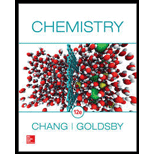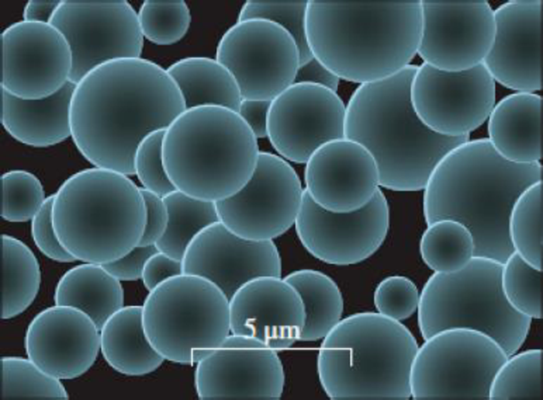
Chemistry
12th Edition
ISBN: 9780078021510
Author: Raymond Chang Dr., Kenneth Goldsby Professor
Publisher: McGraw-Hill Education
expand_more
expand_more
format_list_bulleted
Concept explainers
Textbook Question
Chapter 2, Problem 2.122IME
One technique proposed for recycling plastic grocery bags is to heat them at 700°C and high pressure to form carbon microspheres that can be used in a number of applications. Electron microscopy shows some representative carbon microspheres obtained in this manner, where the scale is given in the bottom right corner of the figure. Determine the number of carbon atoms in a typical carbon microsphere.

Expert Solution & Answer
Want to see the full answer?
Check out a sample textbook solution
Students have asked these similar questions
7A.6
Before solving the problem please also give a brief explanation of the concept or associated equation(s) and variables.
Believe answer should be something like 1.3 x 106 m/s
7.8
Before solving the problem please also give a brief explanation of the concept or associated equation(s) and variables.
I think answers should be (1,4) and (2,2)
N2O(g) is a nonlinear molecule with 3 vibrational modes with values of 1900K, 1080K, and 2330K. Calculate the molar heat capacity of C_V,m of N2O(g) at 300K.
I'm unsure if I should be calculating only vibrational contribution or if this means total of all contributions
Chapter 2 Solutions
Chemistry
Ch. 2.1 - The atoms of elements A (blue) and B (orange) form...Ch. 2.3 - How many protons, neutrons, and electrons are in...Ch. 2.3 - Review of Concepts
What is the atomic number of an...Ch. 2.4 - In viewing the periodic table, do chemical...Ch. 2.5 - Review of Concepts
what does S8 signify? How does...Ch. 2.6 - Write the empirical formula for caffeine...Ch. 2.6 - Prob. 4PECh. 2.6 - Prob. 1RCCh. 2.7 - Name the following compounds: (a) PbO and (b)...Ch. 2.7 - Prob. 6PE
Ch. 2.7 - Name the following molecular compounds: (a) NF3...Ch. 2.7 - Prob. 8PECh. 2.7 - Prob. 1RCCh. 2.7 - Prob. 9PECh. 2.7 - Prob. 2RCCh. 2.8 - Prob. 1RCCh. 2 - Prob. 2.1QPCh. 2 - Name the types of radiation known to be emitted by...Ch. 2 - Compare the properties of the following: ...Ch. 2 - What is meant by the term fundamental particle?Ch. 2 - Describe the contributions of the following...Ch. 2 - Describe the experimental basis for believing that...Ch. 2 - The diameter of a helium atom is about 1 102 pm....Ch. 2 - Prob. 2.8QPCh. 2 - Use the helium-4 isotope to define atomic number...Ch. 2 - Why do all atoms of an element have the same...Ch. 2 - What do we call atoms of the same elements with...Ch. 2 - Explain the meaning of each term in the symbol...Ch. 2 - What is the mass number of an iron atom that has...Ch. 2 - Calculate the number of neutrons in 239Pu.Ch. 2 - Prob. 2.15QPCh. 2 - Indicate the number of protons, neutrons, and...Ch. 2 - Write the appropriate symbol for each of the...Ch. 2 - Write the appropriate symbol for each of the...Ch. 2 - What is the periodic table, and what is its...Ch. 2 - State two differences between a metal and a...Ch. 2 - Write the names and symbols for four elements in...Ch. 2 - Define, with two examples, the following terms:...Ch. 2 - Prob. 2.23QPCh. 2 - Describe the changes in properties (from metals to...Ch. 2 - Consult a handbook of chemical and physical data...Ch. 2 - Group the following elements in pairs that you...Ch. 2 - Prob. 2.27QPCh. 2 - Prob. 2.28QPCh. 2 - Describe the two commonly used molecular models.Ch. 2 - Prob. 2.30QPCh. 2 - Prob. 2.31QPCh. 2 - Prob. 2.32QPCh. 2 - Identify the following as elements or compounds:...Ch. 2 - Prob. 2.34QPCh. 2 - Give the number of protons and electrons in each...Ch. 2 - Give the number of protons and electrons in each...Ch. 2 - What does a chemical formula represent? What is...Ch. 2 - Define molecular formula and empirical formula....Ch. 2 - Give an example of a case in which two molecules...Ch. 2 - Prob. 2.40QPCh. 2 - Prob. 2.41QPCh. 2 - Prob. 2.42QPCh. 2 - Prob. 2.43QPCh. 2 - Prob. 2.44QPCh. 2 - What are the empirical formulas of the following...Ch. 2 - What are the empirical formulas of the following...Ch. 2 - Write the molecular formula of glycine, an amino...Ch. 2 - Write the molecular formula of ethanol. The color...Ch. 2 - Prob. 2.49QPCh. 2 - Prob. 2.50QPCh. 2 - Prob. 2.51QPCh. 2 - Prob. 2.52QPCh. 2 - Prob. 2.53QPCh. 2 - Prob. 2.54QPCh. 2 - Prob. 2.55QPCh. 2 - Prob. 2.56QPCh. 2 - Name these compounds: (a) Na2CrO4, (b) K2HPO4, (c)...Ch. 2 - Prob. 2.58QPCh. 2 - Prob. 2.59QPCh. 2 - Prob. 2.60QPCh. 2 - Sulfur (S) and fluorine (F) form several different...Ch. 2 - Prob. 2.62QPCh. 2 - Pair the following species that contain the same...Ch. 2 - Write the correct symbols for the atoms that...Ch. 2 - Prob. 2.65QPCh. 2 - In which one of the following pairs do the two...Ch. 2 - Prob. 2.67QPCh. 2 - Prob. 2.68QPCh. 2 - Determine the molecular and empirical formulas of...Ch. 2 - What is wrong with or ambiguous about the phrase...Ch. 2 - Prob. 2.71QPCh. 2 - Which of the following are elements, which are...Ch. 2 - Prob. 2.73QPCh. 2 - Prob. 2.74QPCh. 2 - Each of the following pairs of elements will react...Ch. 2 - Match the descriptions [(a)(h)] with each of the...Ch. 2 - Explain why anions are always larger than the...Ch. 2 - Prob. 2.78QPCh. 2 - Caffeine, shown here, is a psychoactive stimulant...Ch. 2 - Prob. 2.80QPCh. 2 - Prob. 2.81QPCh. 2 - Prob. 2.82QPCh. 2 - Fill in the blanks in the following table.Ch. 2 - Prob. 2.84QPCh. 2 - Write the formula of the common ion derived from...Ch. 2 - Prob. 2.86QPCh. 2 - Prob. 2.87QPCh. 2 - Of the 118 elements known, only two are liquids at...Ch. 2 - Prob. 2.89QPCh. 2 - Prob. 2.90QPCh. 2 - Prob. 2.91QPCh. 2 - Prob. 2.92QPCh. 2 - Prob. 2.93QPCh. 2 - Prob. 2.94QPCh. 2 - List five elements each that are (a) named after...Ch. 2 - Prob. 2.96QPCh. 2 - Fluorine reacts with hydrogen (H) and deuterium...Ch. 2 - Prob. 2.98QPCh. 2 - Identify each of the following elements: (a) a...Ch. 2 - Prob. 2.100QPCh. 2 - Show the locations of (a) alkali metals, (b)...Ch. 2 - Fill the blanks in the following table.Ch. 2 - Prob. 2.103QPCh. 2 - In Section 2.1 it was pointed out that mass and...Ch. 2 - Draw all possible structural formulas of the...Ch. 2 - Prob. 2.106QPCh. 2 - Draw two different structural formulas based on...Ch. 2 - Prob. 2.108QPCh. 2 - Prob. 2.109QPCh. 2 - A monatomic ion has a charge of +2. The nucleus of...Ch. 2 - In the following 2 2 crossword, each letter must...Ch. 2 - Prob. 2.112QPCh. 2 - Prob. 2.113QPCh. 2 - Prob. 2.114QPCh. 2 - Prob. 2.115QPCh. 2 - Prob. 2.116IMECh. 2 - Prob. 2.117IMECh. 2 - Prob. 2.118IMECh. 2 - Prob. 2.119IMECh. 2 - Prob. 2.120IMECh. 2 - Prob. 2.121IMECh. 2 - One technique proposed for recycling plastic...
Knowledge Booster
Learn more about
Need a deep-dive on the concept behind this application? Look no further. Learn more about this topic, chemistry and related others by exploring similar questions and additional content below.Similar questions
- 6.13 Before solving the problem please also give a brief explanation of the concept or associated equation(s) and variables. The pseudofirst-order rate constant for the decomposition of urea, CO(NH2)(aq) + 2 H₂O(l) → 2NH4(aq) + CO3²¯(aq), is 1.2 × 10^-7 s¹ at 60 °C and 4.6 × 10^-7 s¯¹ at 70 °C. Estimate (a) the activation Gibbs energy and (b) the entropy of activation of the reaction. PLEASE SOLVE FOR PART B!!!!!arrow_forward(6) Provide all of the products for the reaction of one equivalent of HBr to 1,3-butadiene?arrow_forwardYou find an antique car jack like the one shown in the figure at an estate sale. After cleaning it up, you establish that the amount of friction is negligible and that the input and output pistons have a diameter of 0.44 in. and 2.1 in., respectively. Determine the force F needed to support a 1000-lb load at the output piston. lb 1000 lb Additional Materials -3.0 in. 12 in. input piston output pistonarrow_forward
- jrjarrow_forwardConsider the following four compounds: NaCl H₂O C₁₂ IBr Which of the following statement(s) about these four compounds is/are true? (Select all that apply.) H₂O has a higher boiling point than NaCl because H₂O can form the relatively strong hydrogen bonding intermolecular forces. Cl₂ has a higher boiling point than NaCl because Cl₂ will have the stronger London dispersion forces. H₂O has the strongest London dispersion forces of all these compounds. IBr has the strongest ionic forces of all these compounds. IBr has a higher boiling point than Cl₂ because IBr has additional dipole forces that are not present in Cl₂.arrow_forwardthe characteristic vibrational temperature for CO is 3103K. Calculate the vibrational contribution to the molar heat capacity of CO(g) at 1400Karrow_forward
arrow_back_ios
SEE MORE QUESTIONS
arrow_forward_ios
Recommended textbooks for you
 Introductory Chemistry: A FoundationChemistryISBN:9781285199030Author:Steven S. Zumdahl, Donald J. DeCostePublisher:Cengage Learning
Introductory Chemistry: A FoundationChemistryISBN:9781285199030Author:Steven S. Zumdahl, Donald J. DeCostePublisher:Cengage Learning Chemistry: The Molecular ScienceChemistryISBN:9781285199047Author:John W. Moore, Conrad L. StanitskiPublisher:Cengage Learning
Chemistry: The Molecular ScienceChemistryISBN:9781285199047Author:John W. Moore, Conrad L. StanitskiPublisher:Cengage Learning ChemistryChemistryISBN:9781305957404Author:Steven S. Zumdahl, Susan A. Zumdahl, Donald J. DeCostePublisher:Cengage Learning
ChemistryChemistryISBN:9781305957404Author:Steven S. Zumdahl, Susan A. Zumdahl, Donald J. DeCostePublisher:Cengage Learning
 Living By Chemistry: First Edition TextbookChemistryISBN:9781559539418Author:Angelica StacyPublisher:MAC HIGHER
Living By Chemistry: First Edition TextbookChemistryISBN:9781559539418Author:Angelica StacyPublisher:MAC HIGHER Chemistry & Chemical ReactivityChemistryISBN:9781337399074Author:John C. Kotz, Paul M. Treichel, John Townsend, David TreichelPublisher:Cengage Learning
Chemistry & Chemical ReactivityChemistryISBN:9781337399074Author:John C. Kotz, Paul M. Treichel, John Townsend, David TreichelPublisher:Cengage Learning

Introductory Chemistry: A Foundation
Chemistry
ISBN:9781285199030
Author:Steven S. Zumdahl, Donald J. DeCoste
Publisher:Cengage Learning

Chemistry: The Molecular Science
Chemistry
ISBN:9781285199047
Author:John W. Moore, Conrad L. Stanitski
Publisher:Cengage Learning

Chemistry
Chemistry
ISBN:9781305957404
Author:Steven S. Zumdahl, Susan A. Zumdahl, Donald J. DeCoste
Publisher:Cengage Learning


Living By Chemistry: First Edition Textbook
Chemistry
ISBN:9781559539418
Author:Angelica Stacy
Publisher:MAC HIGHER

Chemistry & Chemical Reactivity
Chemistry
ISBN:9781337399074
Author:John C. Kotz, Paul M. Treichel, John Townsend, David Treichel
Publisher:Cengage Learning
The Bohr Model of the atom and Atomic Emission Spectra: Atomic Structure tutorial | Crash Chemistry; Author: Crash Chemistry Academy;https://www.youtube.com/watch?v=apuWi_Fbtys;License: Standard YouTube License, CC-BY